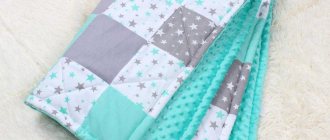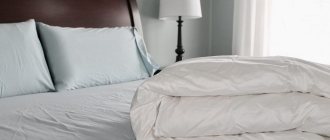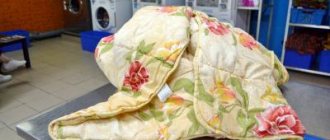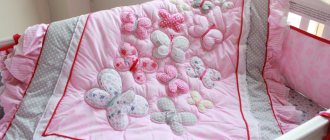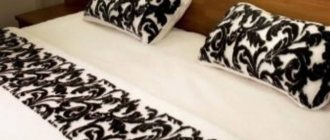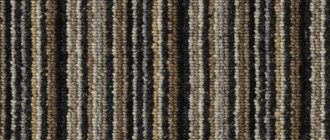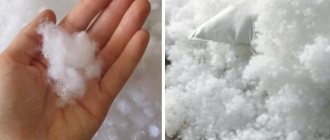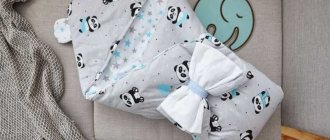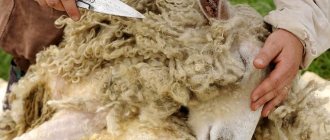Properties of wool fillings for blankets
Wool options are ideal for winter. The following types of wool are used for filling.
camel
It pricks if it is outside. You can't feel it in the case. Absorbs moisture up to 30% of its weight. Lets air through. Useful for diseases of bones and joints. Due to the prickliness, a light massage of the skin is obtained, rejuvenating and making it elastic. This is a warm and light blanket, cozy and durable.
Camel fluff does not prick, it is soft and gentle. It is collected from the cubs. Used for open blankets.
Sheep
Soft, pleasant, cozy. Wear-resistant. Relaxes tired muscles. Products made from sheep's wool are heavy and will be pleasant to those who love peace. Gives a feeling of reliability. Absorbs and releases moisture well, breathable.
Merino wool - an Australian sheep - is considered the best among sheep wool. Capable of self-cleaning.
Virgin
It is collected from lambs for 4-6 months by hand and is not processed in any way. It is very thin, delicate, soft, shiny. It is considered an elite material.
Cashmere
Cashmere blanket is the lightest, warmest and softest. It calms the nervous and muscular system, removes fatigue. Cashmere is light down from the chest and neck of a goat that lives in the Himalayas. Expensive luxury items are made from cashmere.
What wool is the warmest for blankets: camel or any down-undercoat.
What is an adjustable weight blanket
Weighted blankets are accessories produced using special technology. They consist of many small pockets, each of which contains a specific number of microspheres.
Weighted blankets differ in weight from standard blankets. They are much heavier. Usual weight is from 2 to 13 kilograms.
To fill weighted accessories, natural materials or small plastic beads are used (when the product needs to be given the structure of a toy).
Large weight retains heat and gently presses on the body of a sleeping person. An imitation of hugs and a feeling of closeness is created.
Reviews left on the Internet, as well as research by doctors, prove that weighted items improve sleep, the mood of an already awakened person, and reduce feelings of anxiety and restlessness. They are used in the treatment of sensory disorders (autism, ADHD).
Down, feather (down-feather species)
What is the warmest filling for a duvet – down, of course. The following types are used for duvets:
- Eider down is the rarest and most expensive, soft and cozy. It is rare to find. Warms better than other types of down.
- White and gray goose down is common. The products are very soft, warm, durable.
- Duck down is cheaper than others. Not as warm, less durable.
Duvet pros and cons:
- absorbs moisture up to 45% of its own weight;
- allows air to pass through;
- service life 15-20 years;
- causes allergies;
- difficult care;
- It is difficult to remove the resulting moisture outside.
Waterfowl down is considered the warmest material for winter species.
Contents - what's inside?
1. The warmest blankets are those filled with down and feathers. For filling, feathers from waterfowl are used: loons, ducks and geese. It is comfortable under such a blanket all year round. It retains heat well, quickly warms up from body heat, allows air to pass through well, and the body “breathes” under it. Blankets with duck down are cheaper than others with such filling, but have a slight disadvantage. Over time, the filler may clump. Another negative point: such blankets are not suitable for those with allergies. Although most problems arise due to the fault of parasites that settle in the filler.
2. Manufacturers take care of the purity of the filler, treating it with special solutions that prevent the development of a harmful environment. But over time, various lice eaters and mites still settle in the filler. To do this, from time to time such a blanket must be given for special cleaning.
3. Next, wool blankets are considered one of the warmest. They are stuffed with wool from sheep or, better yet, from camels. Just like a down blanket, a duvet retains heat and allows air to pass through. The disadvantages are the same as when choosing a duvet: allergies to natural filler, fungi and mites. With proper care, this blanket will last quite a long time.
4. Cotton as a filler. This natural material of plant origin, not so warm and warming, is chosen mainly because of its hygroscopicity. This blanket can be washed in a washing machine.
5. One of the varieties of cotton blankets is cotton blankets. But they are not very popular, as they have a lot of weight, lose quality and do not provide much heat. Since there are many other modern fillers, consumer interest in wadding blankets is disappearing.
6. Filler of plant origin, but made from bamboo. It allows air to pass through well, warms and, importantly, is hypoallergenic. This blanket is easy to care for and can be used all year round.
7. And finally, synthetics is a word that is alarming. But in vain. Yes, if you choose a completely budget option, with padding polyester, you may experience some disappointment. A blanket filled with holofiber is of better quality. Its difference is that this filler does not fall into lumps over time. These blankets provide excellent warmth, are light and soft, and are suitable for all-season use.
/ 2216
Read on:
- ‘); ‘); ‘); ‘);
Types of blankets
To choose the best blanket for a comfortable sleep, you need to consider several criteria:
- Product heat level;
- Hypoallergenic (not all options are suitable for allergy sufferers);
- Hygroscopicity of the model (how it absorbs moisture);
- Lightweight and breathable;
- The fabric from which the cover is made;
- How difficult is it to care for the product?
- Product size.
Do you like to steam and relax in the bath? It will be even more comfortable for you if you place a special bath pillow under your head; you can also put special bags of herbs in it for a better effect.
Does someone close to you often snore at night? This can often be corrected by simply choosing an anti-snoring pillow; read how to do this at the link.
The degree of warmth of a blanket is usually indicated by points from one to five: 1 and 2 are the lightest products for summer, 3 is the usual “demi-season” option, 4 and 5 are insulated.
Moreover, the warmth usually varies within the same line with one filler. For example, quilted wool models are an option for winter, and a lightweight plaid blanket is suitable for hot months.
The fabric from which the blanket cover is made is no less important. It is better to choose natural fabrics, for example, satin and calico. Linen is perfect for summer.
The size range of blankets is very wide, choosing the right option will not be difficult: from children's (110x140, 140x140) and one-and-a-half (140x205, 155x215) to regular double (175x205) and euro (195x215, 200-220, 220x240).
The main thing is to remember the size of the model so that in the future you can easily select bedding to match it.
A high-quality blanket should have excellent air permeability and absorb moisture, not interfere with sleep and not cause irritation on the skin; it should not feel noticeably hot or cold under it.
Read also: Bamboo blanket
Duvet filler
When buying items for sleeping, we begin to think - what is the best filling for a blanket? Here, too, everything depends on your preferences and even your state of health - almost every material has its own pros and cons.
All fillers can be divided into:
Natural:
- Down (goose and duck);
- Wool (camel, merino, sheep);
- Silk;
- Cashmere;
- Cotton and linen;
- Bamboo and eucalyptus.
Synthetic:
- Holofiber;
- Holofitex;
- Artificial swan down;
- Cotton wool.
Are you looking for an orthopedic mattress? A polyurethane foam mattress is a completely synthetic filler that never causes allergies and will never harbor mites, as happens with natural fillers.
Do you get tired after sitting for long periods of time? Read here how to select and use special orthopedic lumbar pillows.
Children often have allergies to natural bedding fillers. Air mattresses for children are absolutely hypoallergenic, more details on this page.
Natural fillings for blankets
If you are deciding how to choose a blanket for the winter, natural materials will be excellent options.
Duvets
Down duvets are a tried and true classic, they are light, soft and provide the best warmth in the winter without being particularly hot underneath in the summer either.
Down perfectly absorbs moisture (for example, if you sweat) and allows air to pass through, but over time it can become damp and become a breeding ground for dust mites. Therefore, down filling is strictly prohibited for allergy sufferers.
The disadvantage of such products is that they are difficult to care for: only some down models can be washed; for the rest, regular airing and dry cleaning are required.
Wool filler
Wool filling - for those who like it warmer. Products made from wool provide good warmth and are recommended for people with joint diseases: the natural lanolin in this filler heals joints and relieves muscle aches.
Which wool is the best for a blanket? The most expensive and high-quality option is camel. Products made from camel wool weigh little and are very comfortable, breathe well and absorb moisture.
Read also: 4 types of bedspreads for a corner sofa
At the same time, they are capable of self-cleaning, which means they do not retain foreign odors. Merino wool filling retains all the benefits of camel, adding even greater strength and durability.
Models made from sheep wool have similar characteristics, but they are heavier, although the price is lower.
However, woolen products can also harbor mites and accumulate dust, so they are not recommended for everyone. Caring for wool blankets is quite simple; if handled correctly, they will last up to 15 years.
Silk filler
Silk is another unusual material that simply has no equal. Winter silk models are the choice of those who like to sleep under a heavy blanket; summer options are very light and airy.
Silk is a hypoallergenic filler, has antibacterial properties and perfectly regulates body temperature at night: you will always be comfortable under such a blanket.
When choosing a silk product, pay attention to the stitching: it is believed that the seams can damage the fiber, so high-quality models may well not be quilted.
Such products have two disadvantages - high cost and difficult care: most models can only be cleaned in dry cleaners.
Vegetable fillers
Excellent fillings for blankets are of plant origin. Cotton and linen perfectly regulate heat balance, absorb excess moisture, and do not provoke allergies.
Bamboo has the same properties, plus it kills bacteria, cares for the skin and even strengthens the immune system while you sleep. It is also possible to add buckwheat husk filler, but be careful, buckwheat is quite a heavy material, there should not be too much of it.
And most importantly, such products can easily withstand numerous washes without losing their unique qualities.
To make it comfortable for you to bathe your baby, we recommend using a special pillow for bathing babies. This could be a large pillow on which the baby is placed, or a neck pillow to help him swim.
Want to make your sofa unique? Read all about how to choose suitable bolster pillows for your sofa here.
Did you know that pillows with gel filling are very popular now? What it is and what benefits this filler provides, read on this page.
Synthetic duvet fillings
When deciding which material is better for a blanket, many people increasingly prefer synthetics, and this is no coincidence.
Read also: Blanket for discharge from maternity hospital
Such products are the most affordable, although an overly cheap option should alert you. They do not absorb moisture, but high-quality models are able to pass it through themselves and evaporate.
Holofiber
Artificial down (synthetic down) breathes best, holofiber is the worst. But microorganisms never grow in artificial materials, so such blankets are completely safe for people with allergies and asthma.
Synthetic products are also very practical - they are the easiest to care for of all varieties; after washing, the filler does not wrinkle or clump together.
Fillers made from vegetable fibers
There are many types of fillers made from natural fibers. They are extracted from various plants.
Silk
Non-allergenic, absorbs liquid, does not wrinkle, does not electrify, does not accumulate dust. If you need to choose a blanket for the summer, a silk one will do. It cools the skin and takes on body temperature.
Silkworm fibers are used for silk blankets. Protein threads are woven together in a chaotic manner.
Eucalyptus, bamboo
Hypoallergenic antibacterial filler. It makes an airy blanket, light and soft. Good hygroscopicity and breathability.
Eucalyptus fruits are useful for people with lung diseases. Bamboo ones are suitable for those with skin diseases. These are blankets with artificial filling.
Seaweed
Improve blood circulation, rejuvenate the skin. They have an antibacterial effect. Using a special manufacturing technology, it does not smell or crumble.
A good product for skin problems. Helps it retain moisture due to the content of nutrients.
Flax fiber
Blankets made of linen fiber have an antistatic and antibacterial effect. Natural fabric perfectly absorbs moisture. Used for bedding for several thousand years.
Cotton
Hygroscopic, breathable, non-allergenic. Suitable for summer. Do not accumulate static electricity, wear-resistant. The cotton blanket does not pill.
A flannelette soft product is made from cotton with the addition of chemical or artificial fibers. It is cozy and light, easy to care for. It is often taken home for babies or preschools.
And now - what types of blankets are there and what is their beauty?
- Duvets
Such blankets are soft, light, voluminous, retain heat well, but at the same time they are expensive, do not tolerate moisture at all and are a breeding ground for dust mites. This is definitely not an option for asthmatics and allergy sufferers. In addition, they require special care (you need to shake, straighten, air, regularly dry clean).
Filling: down and bird feathers in different proportions. Most often, goose ones are used, sometimes swan ones (only swans are in the Red Book). Goose ones are considered the most budget-friendly (they are also less warm and light). They say they are also made from eider down, the warmest and lightest, but it’s indecent to even mention the price for them.
Price: from 1200 RUR to 27000 RUR
- Wool blankets
They are most loved for their good moisture absorption (there will be no “greenhouse” effect) and for their excellent heat retention. Oh yes! And also for, as they say, a healing effect for people with sore joints. I wonder how true this is?
Wool blankets are heavier and coarser than down ones. Old type blankets are unbearably itchy. New manufacturing technologies have taken a step forward in the development of this type of blanket. With high-quality production and good, fairly dense fabrics, they finally don’t itch (which I still have a hard time believing).
There are sheep (coarse, cheap) and camel (one of the warmest). Camel ones, unlike sheep ones, are more popular and are often recommended.
Price: from 800R to 14000R
- Quilts
Who hasn't been crushed under this blanket as a child? It used to be in almost every home. Now we can safely say that this is an outdated filler. Yes, natural, cheap, but heavy, dense, damp over time and losing its shape. Such a blanket inevitably rolls into lumps, acquires odors and has problems with washing; it cannot be dry cleaned. I strongly recommend leaving this look as nostalgia from childhood and putting it in the closet if you happen to have one lying around.
Price: from 400R to 3000R
- Silk blankets
They are still perceived more as some kind of whim or exoticism. They are quite heavy and expensive. One of the features worth noting is that they do not harbor mites and bacteria.
They do not cause allergies and absorb moisture well, maintaining comfort.
In winter, blankets with a large amount of filling are used, and for summer there are, accordingly, light options. Caring for them is considered difficult and is worth researching before purchasing.
Price: from 2500 RUR to infinity?
- Bamboo blankets
They are rapidly gaining popularity due to their affordable price, hypoallergenicity, antibacterial properties and good thermoregulatory properties. They also absorb and evaporate moisture well, do not collect dust and are not electrified. Bamboo is considered a durable material and, if made well, wear-resistant. When you buy bamboo, it’s a bit harsh at first, but becomes softer over time.
Price: from 520R to 4600R
- Eucalyptus blankets
Want to feel like a panda? Eucalyptus blanket - your choice? Lyocell (eucalyptus tree fiber) is 100% natural, safe in all respects, has antimicrobial properties, but requires special care - no more than 40 degrees when washing. A fun factor is the blanket's ability to stay cool even in the summer heat, but there are also “winter” options that are very, very warm. A eucalyptus blanket, in my humble opinion, would make a pretty fun gift for a coziness lover.
Price: from 1180R to 8800R
- Seaweed blankets
Yes, there are some. Almost everywhere they write that the blanket has a pronounced anti-cellulite effect, saturates the body with oxygen and almost sleeps for you. It’s hard to believe and I would hardly recommend choosing this blanket if you are looking for it for yourself and for a long time. You can wash the “sea” blanket in a regular washing machine at a temperature not >60 degrees.
Price: from 1400R to 2500R
These were the main natural fillers in my review. Now - a few words about synthetic ones. In general, they are considered to be “equal in performance” (as good as) to blankets with natural fillings. However, there are many reviews from people that synthetics are less warm and “breathe” worse. They are also less cozy and comfortable.
But it is worth noting their advantages. Synthetic blankets do not cause allergies, are easy to care for, can be easily washed in a regular washing machine and dry quickly, are inexpensive and are not heavy.
Artificial and synthetic
There are different blankets with synthetic filling. They are mainly made from polyester threads.
swansdown
A blanket filled with swan down is a hypoallergenic sleep product that is almost as warm as natural down. The absence of natural fibers makes the item unpleasant for microorganisms and mites.
It is electrified, does not allow or absorb moisture, and does not allow air to pass through.
Polyester
The following materials are available:
- The cheapest padding polyester. Forms clumps, cakes, short-lived.
- The holofiber blanket is elastic, the filler balls prevent it from rolling into lumps. The product made from holofiber is light and warm.
- Siliconized fiber is similar to fluff. These are thin polyester threads coated with silicone.
They make a semi-down blanket, the composition of which is natural down combined with chemical fibers.
Polyester product, pros and cons:
- low hygroscopicity and air permeability;
- electrified;
- inexpensive;
- weighs little;
- easy care;
- average service life.
Polyester fibers have both disadvantages and advantages.
Synthetic fillers versus natural down
Expensive down blankets today are increasingly inferior to synthetic blankets that are more profitable not only in price, but also in functionality. What is their feature? Firstly, they can be safely used by people prone to allergic reactions, and secondly, modern synthetic fillers have many functions that will satisfy even the most demanding consumers. Thus, pillows and blankets filled with polyester fibers can maintain a comfortable temperature for sleeping, which is especially important when choosing a blanket for children - you will not worry that the baby will become hot under a warm blanket. Cassette sewing technology also provides a function such as cooling, so the filler does not get wet if you sweat, and therefore there is no risk of bed mites.
Another benefit of choosing blankets filled with high-quality synthetic materials is ease of care; they can often even be washed in an automatic washing machine, after which they dry quickly enough and regain their original shape, without bunching up or losing volume.
But there is one point in which many synthetic blankets are inferior to natural ones - they do not have full air circulation. Woolen and down blankets “breathe” best, but for synthetic ones it is recommended to choose cotton covers to satisfy the air exchange function.
Fabric for the cover
Fabric for a blanket, which is better:
- Duvet, how to choose fabric: you need a material with a dense weave that does not release down and feathers. It is impregnated with a special solution.
- It is better to choose a thick, cotton cover for the blanket if it is made of wool. Percale, twill, teak are suitable.
- Thin, delicate materials – cambric, satin – are suitable for a down product or one with underfur.
- For silk, a cover made of thick cotton or silk is suitable. These threads go well together. Satin jacquard weave fabric is suitable.
The inner and outer material must be combined for the product to last a long time.
Bamboo blanket
This type of blanket appeared in Russia not so long ago, and has already become popular.
A real “hit” in the bedding market, reminiscent of silk in its quality. The perfect blanket for winter and summer.
Advantages:
- Does not cause allergic reactions.
- Absorbs moisture well.
- Provides high-quality air exchange.
- Lightweight, soft and comfortable.
- Easy to wash (withstands up to 500 washes) and does not require ironing.
- Easy to care for.
- Wear-resistant and durable.
- Does not accumulate unpleasant odors.
Flaws:
- It is difficult to find a truly high-quality product (there are many fakes).
- The blanket is so light (although it is warmer than a down blanket) that you have to get used to it.
Choice
Choosing a blanket, tips and tricks:
- Fiber options - bamboo, eucalyptus, linen - should be reserved for the warm season.
- The blanket is all-season, which means: it is suitable for any season. It comes from any materials. Therefore, you need to find out the types of density of a particular filler and choose the average one. The all-season blanket is collapsible. There is a thin summer half and a thicker demi-season half. They are fastened with buttons and it turns out winter. Thermal conductivity is important. The product should warm in winter and cool in summer.
- If you want a blanket that is warm and light, you should choose down or swan's down.
- We choose a duvet: it should be light, without an unpleasant odor. Shape stability - if you crumple a piece of a thing and let it go, after 20 minutes it will become the same. If the composition contains feathers, they should be small and not prickly.
- How to choose a blanket based on filling: synthetic, bamboo or eucalyptus are suitable for allergy sufferers. For hot climates, they are recommended from natural fibers. In the cold, down or wool is better.
- How to choose blankets and pillows. The pillow should follow the shape of your neck. When purchasing at the same time, it is worth purchasing both products from the same trusted manufacturer, this will make it easier to care for them.
- For a patchwork blanket, padding polyester is usually chosen. If you want naturalness, it would be right to pay attention to the cotton version.
- What is the warmest blanket made of: down. Wool ones are also quite warm. Depending on the density, they can sometimes be warmer than down ones. Warm blanket filling can be synthetic if the density is high and the material allows air to circulate.
What is the best material to buy from: camel or merino wool is suitable for durability, down is suitable for warmth. For lightness - bamboo, eucalyptus, synthetics.
On a note
Interesting: horse products are not made from horse hair. This is the name given to a thin blanket that gets tangled in the legs.
Wool blankets
An excellent option for the winter - natural, and even with medicinal properties. An ideal blanket for people with rheumatism, diseases of the spine or bronchi.
The type of blanket depends on the wool used as filler:
- Sheep's wool. A relatively inexpensive blanket, lightweight, perfectly absorbs moisture and allows air to pass through.
- Merino wool. This Australian sheep wool blanket is considered to be of very high quality and is warmer (and also heavier).
- Llama wool. A very soft, durable and elastic blanket. Pleasant to the touch, without pilling and with high heat resistance.
- Camel wool. There are also many advantages: it does not cake, absorbs moisture well, “breathes” and does not become electrified.
Blankets made of wool can be quilted or blankets (1st - for winter, 2nd - for summer).
Advantages:
- Excellent warmth in cold weather.
- Not too heavy.
- Easy to clean and even washable.
- Costs less than duvets.
- Less bulky than a duvet (takes up little space when folded).
- Strength and wear resistance.
Flaws:
- Heavier than down - almost 2 times.
Manufacturers
Rating of companies making blankets:
- The ranking is topped by the well-known Shchigrov down and feather factory, Belashoff. She produces a variety of bed textiles.
- One of the popular brands is CLEO. The types of blankets and other bedding items are constantly being updated. All products comply with international quality standards and have all the necessary certificates.
- Medium-priced ComfortLine textiles are made from a good cotton base. Imported materials.
- Primavelle - the best eco-friendly products with beautiful designs.
- Silk varieties of Chinese origin are represented in Russia by the company Southern Path. They have all the necessary certificates.
- Average prices from the manufacturer Verossa. There are options with a variety of fillings - bamboo, algae, swan fluff, camel hair.
These are the best blanket manufacturers with a large assortment and good quality.
Reviews:
Valeria, 53 years old: I have had a camel blanket for almost 20 years. It is thick and warms well in winter. When I lie under it, my back stops hurting.
Anton, 27 years old: I sleep under down all year round. It’s cold at home, even in summer I can’t stay warm without my favorite blanket. But in the summer I sweat a lot under it.
Karina, 31 years old: constant allergies prevent me from using anything other than synthetics. But I’m thinking of trying bamboo, they say it helps with allergies.
Vasily, 48 years old: I sleep like in childhood, under a flannelette blanket. I have a thin one, so in winter I tuck two into the duvet cover at once. But I don’t like synthetics, it’s hot and uncomfortable.
For a comfortable sleep, you need to choose the right bedding. The bedspread will give you a pleasant sleep or prevent you from getting a good night's sleep.
© 2021 textiletrend.ru
Quilts
Products made from environmentally friendly filler. It was under them that our grandparents slept.
Today, the popularity of quilted blankets has dropped to a minimum - and there are certain reasons for this.
Flaws:
- Too heavy.
- Extremely difficult to care for (impossible to wash, and cleaning is labor-intensive).
- Absorbs odors, including unpleasant ones, and practically does not erode.
- Crumples.
- Poor air exchange.
Advantages:
- Low cost.
- Long service life.
- No allergy to the filler.
- Environmentally friendly “filling”.
- Excellent warmth in winter.
Synthetic blankets
A relatively cheap option with a number of advantages, but not without drawbacks.
Suitable for people with allergies to wool and down.
Advantages:
- Light and pleasant to the body (still new).
- Do not cause allergies.
- They don't crumple.
- Easy care and washable.
- Does not absorb odors and dust.
- Dries quickly.
Flaws:
- Low service life.
- Poor air exchange.
- Too hot for summer.
Silicone blankets
Functional and environmentally friendly, almost weightless material. For the “filling”, a hollow spiral-shaped fiber (siliconized polyester) is used.
The properties of the blanket are close to the wool version. The popularity of such blankets has been growing recently.
Advantages:
- High-quality air exchange.
- Heat retention and moisture evaporation.
- Does not absorb odors and does not cause allergies.
- Lightweight, comfortable and warm.
- Retains its shape even after washing and long-term use.
- Not a source for mites, fungi, mold, etc.
- Low price
Flaws:
- Environmentally friendly, but not natural material.
How to clean a mattress at home - remove stains and dirt from the mattress!
